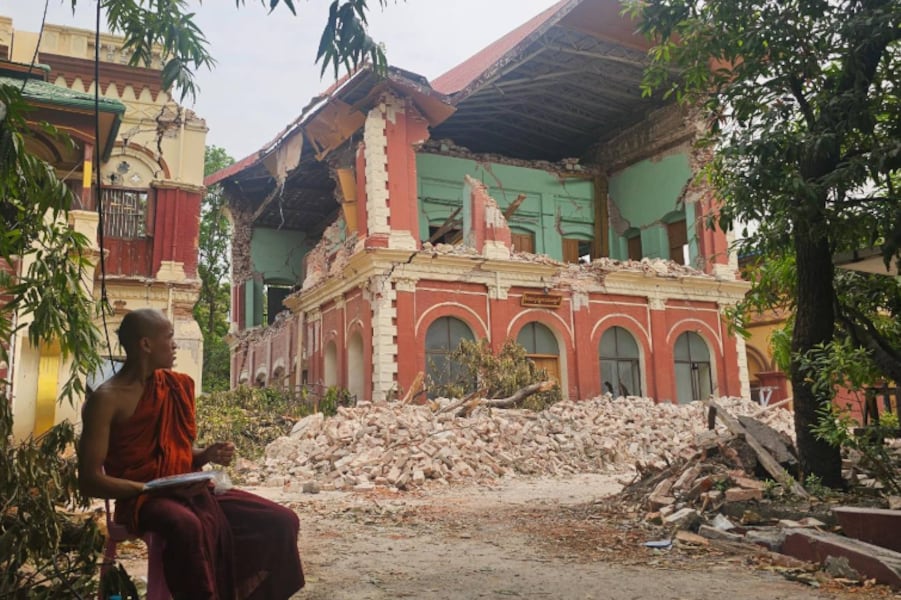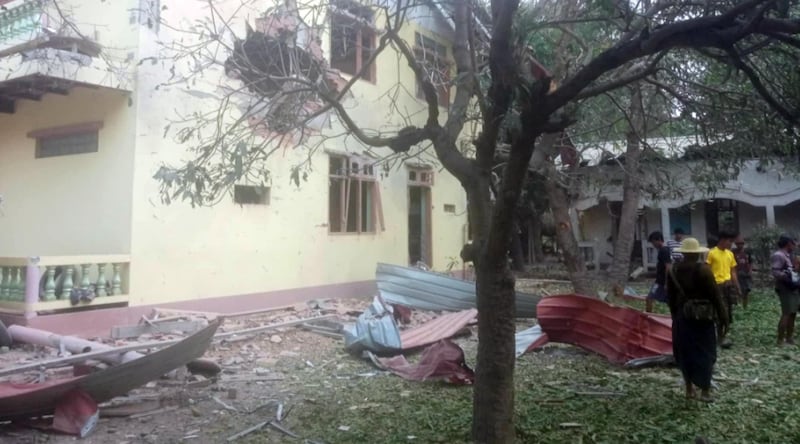The junta said a recent earthquake destroyed almost 10,000 religious buildings in the country.
By RFA Burmese
2025.04.14


Myanmar’s junta bombed a monastery in the country’s northwest on Saturday, killing five people, including children, just one day before it publicly announced that a recent earthquake had destroyed almost 10,000 religious buildings across the country.
The airstrike in Tabayin township, Sagaing region, injured nine others and reduced a monastery to rubble, according to the Tabayin Brotherhood Organization, which supports displaced civilians.
“Around 1 p.m., a military plane opened fire on the monastery outside Kya Khat village,” a member of the organization said, speaking on condition of anonymity due to security risks. “Three child monks, one student and a civilian fleeing conflict were killed.”
Additional junta airstrikes on Sunday in Mindat township, Chin state – now under control of the Chin Brotherhood alliance – destroyed more buildings, including the Myoma Baptist Church, residents said.

The attack came amid ongoing clashes and aerial bombardments in Sagaing and Mandalay regions, which have been severely impacted both by conflict and the powerful 7.7 magnitude earthquake that struck on March 28. The disaster has so far claimed more than 3,600 lives and caused widespread structural damage, including the collapse of religious sites.
Yet, while the junta continues to launch airstrikes across the country – including on religious institutions – it released a report through state-run media the following day blaming the earthquake for widespread damage to sacred sites.
According to its figures, almost 10,000 religious buildings were destroyed, including over 5,000 stupas, 3,800 monasteries, 180 nunneries, 130 mosques, 50 churches, 26 Hindu temples and one Chinese temple.
Nearly 160 monks and 55 nuns were reported killed in the quake, with 177 others injured. In Mandalay’s Bone Oe village, three collapsed mosques reportedly killed 140 worshippers.
Despite the devastation, local communities have begun efforts to restore places of worship, though rebuilding requires approval from the very military responsible for much of the destruction.
The military previously announced that international aid groups who wanted to provide assistance to earthquake-hit areas of Myanmar must gain prior approval from junta authorities
“We, along with state authorities, will rebuild the mosque,” said Nay Zaw Aung, chairperson of the Amarapura-based Charity Social Action Association. “All of the earthquake-affected people will be happy that we will continue to actively participate in its reconstruction.”
Myanmar is home to a vast number of religious buildings, reflecting its rich cultural and religious heritage. While precise figures are challenging to calculate due to the country’s ongoing conflicts and limited access to comprehensive data, estimates suggest that there are over 50,000 Buddhist temples, pagodas and monasteries across the country.
In addition to Buddhist sites, Myanmar also hosts numerous Christian churches, mosques, Hindu temples and other places of worship, particularly in regions with diverse ethnic and religious communities, although the exact numbers for these religious buildings are not available.
Translated by Kiana Duncan. Edited by Taejun Kang.
